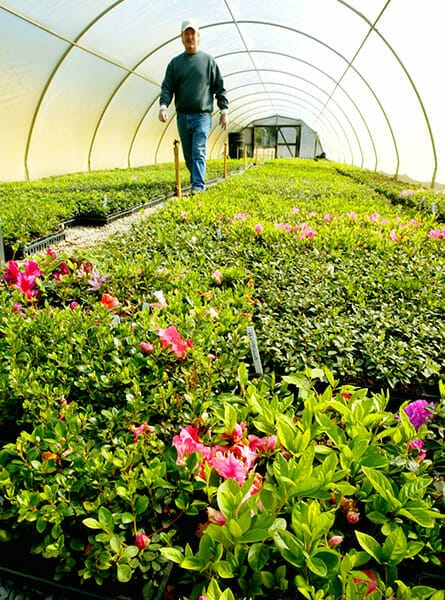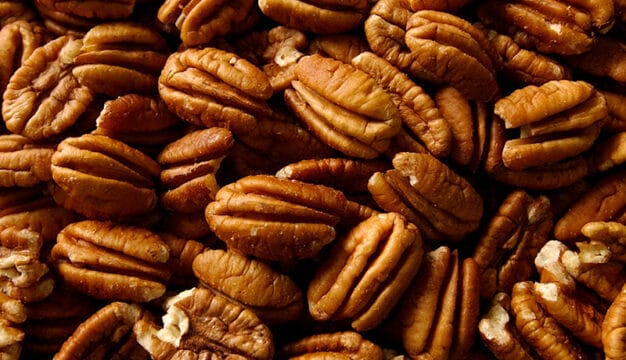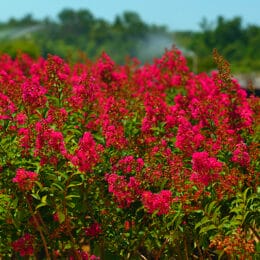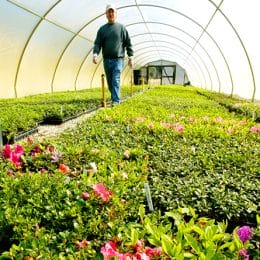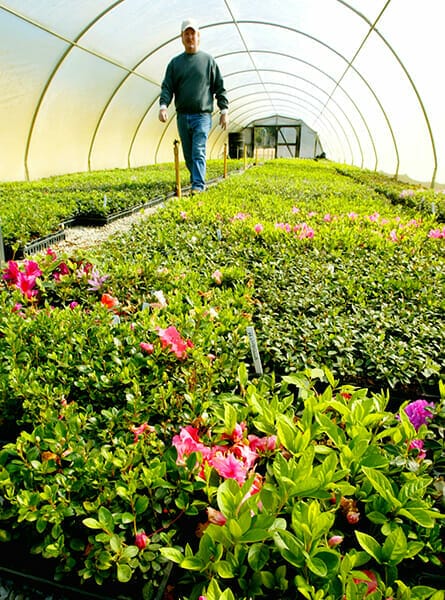Ornamental Nursery Crops Production
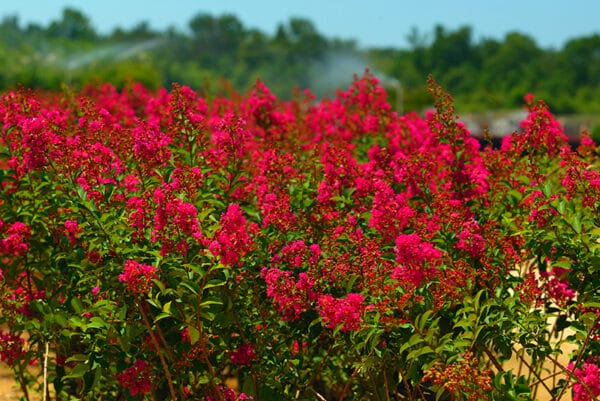 Crape Myrtles in Mobile County
The production of ornamental nursery crops in Alabama dates back to 1852, when C. C. Langdon first began offering natives plants such as Gordonia (Gordonia lasianthus) and anise tree (Illicium sp.) at his Vineland Nursery in Citronelle, north of Mobile. Since that time, ornamental production (nursery, greenhouse, and sod production) in Alabama has evolved into the third largest sector of agriculture in the state, behind only poultry and eggs and cattle and calves. Most of the nursery production in Alabama is located in Mobile and Baldwin counties, although some production is found in every county in the state. South Alabama is know across the country as the azalea capital because more of the popular spring-blooming azalea plants are grown in Mobile and Baldwin county nurseries than anywhere else in the country.
Crape Myrtles in Mobile County
The production of ornamental nursery crops in Alabama dates back to 1852, when C. C. Langdon first began offering natives plants such as Gordonia (Gordonia lasianthus) and anise tree (Illicium sp.) at his Vineland Nursery in Citronelle, north of Mobile. Since that time, ornamental production (nursery, greenhouse, and sod production) in Alabama has evolved into the third largest sector of agriculture in the state, behind only poultry and eggs and cattle and calves. Most of the nursery production in Alabama is located in Mobile and Baldwin counties, although some production is found in every county in the state. South Alabama is know across the country as the azalea capital because more of the popular spring-blooming azalea plants are grown in Mobile and Baldwin county nurseries than anywhere else in the country.
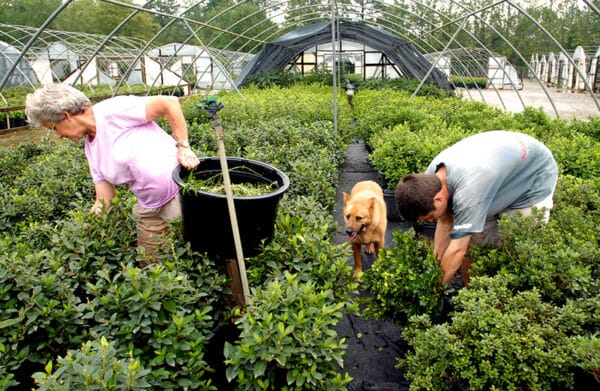 St. Clair County Greenhouse
Plant nurseries in Alabama range in size from small backyard “mom and pop” operations to large companies with hundreds of acres employing hundreds of people and producing millions of plants. Nurseries produce plants primarily in containers (container-grown) or in the field (field-grown). There are literally hundreds, if not thousands, of ornamental plant species produced in Alabama nurseries. The majority of ornamental plants are propagated via rooting of plant cuttings, budding, grafting, or division, but others are produced from seed.
St. Clair County Greenhouse
Plant nurseries in Alabama range in size from small backyard “mom and pop” operations to large companies with hundreds of acres employing hundreds of people and producing millions of plants. Nurseries produce plants primarily in containers (container-grown) or in the field (field-grown). There are literally hundreds, if not thousands, of ornamental plant species produced in Alabama nurseries. The majority of ornamental plants are propagated via rooting of plant cuttings, budding, grafting, or division, but others are produced from seed.
In container production, small plants called liners are placed in larger containers in a soilless potting media primarily composed of aged pine bark. These container-grown plants are placed on top of the ground in a well-drained field that is usually covered in limestone gravel or landscape fabric to minimize weed growth. Plants are intensely managed and in many cases are watered daily during the hot summer months. The majority of container plants are sold through retail outlets ranging from roadside seasonal plant stands to large mass merchandisers. Others are sold through landscape contractors as part of a landscaping service. There are literally thousands of species of plants produced in the state. The most widely sold trees are oaks and maples, and the most popular shrubs are species of azaleas, hollies, and junipers. One of the most widely recognized and produced plants is crape myrtle, which is considered either a shrub or small tree depending on the particular species.
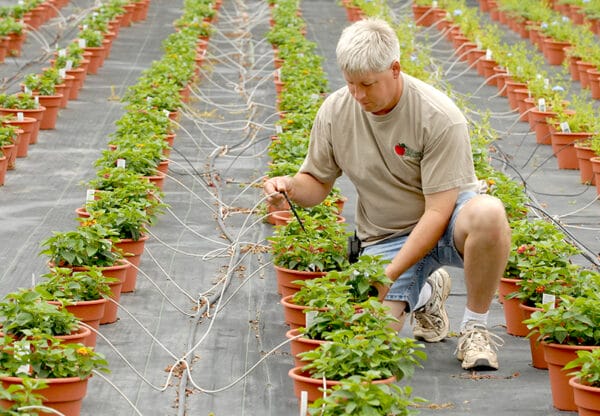 Drip Irrigation System in Jefferson County
In field production, small bare-root or container-grown plants are lined-out, or planted, in the field, usually during the dormant season. Plants grown in the field are typically trees and large shrubs. These plants are allowed to grow for one or more seasons in the field and then are harvested and sold as bare-root plants or as balled and burlapped trees or shrubs. Plants are hand-dug or are removed by mechanical harvesting machines commonly known as tree spades. Given their large size and great weight, these types of ornamentals require specialized handling, making them virtually impossible for mass merchandisers to offer. The majority of field-grown plants are sold through the landscape trade or at specialized independent retail garden centers throughout the state. A significant number of ornamental plants produced in the state are shipped to other states.
Drip Irrigation System in Jefferson County
In field production, small bare-root or container-grown plants are lined-out, or planted, in the field, usually during the dormant season. Plants grown in the field are typically trees and large shrubs. These plants are allowed to grow for one or more seasons in the field and then are harvested and sold as bare-root plants or as balled and burlapped trees or shrubs. Plants are hand-dug or are removed by mechanical harvesting machines commonly known as tree spades. Given their large size and great weight, these types of ornamentals require specialized handling, making them virtually impossible for mass merchandisers to offer. The majority of field-grown plants are sold through the landscape trade or at specialized independent retail garden centers throughout the state. A significant number of ornamental plants produced in the state are shipped to other states.
Several historical events in the past century have led to the development and expansion of the ornamental nursery industry in Alabama and across the country as well. The passage of the Plant Quarantine Act (PQA) of 1912 protected against the entry of dangerous insects and diseases on plant or plant products imported from foreign countries. The PQA virtually eliminated plant imports, resulting in potential new markets for Alabama nurseries. In the mid-1930s, the development of a commercially available rooting hormone sparked a major expansion in the nursery industry. Use of concentrated rooting hormones lessened the rooting period of a cutting from up to a year to a matter of days. The first commercial product, Hormodin, was presented to Alabama nurserymen at the Southern Nurserymen’s Association meeting in Nashville in 1937, by Rudolph Hach & Company. This hormone rooting stimulant enabled the nurseryman to mass produce uniform rooted cuttings needed for the millions of soon-to-be container-grown plants. The garden center industry also began to flourish after World War II, with increasing home construction throughout the country. The garden center revolutionized the marketing and distribution of nursery stock plants and greatly increasing public awareness of and demand for ornamental plants.
Several pioneering figures were at the forefront of the Alabama nursery industry. For example, Henry B. Chase, moved to Alabama from Livermore, Maine, in the late nineteenth century. He established the Alabama Nursery, located in Huntsville, and later re-established it as the Chase Nursery Company in Chase, Madison County, northeast of Huntsville. He initially operated his nursery as a mail-order business before entering the wholesale nursery business. Birmingham nursery owner and landscaper Ollie W. Fraser developed many popular varieties of hollies, particularly of the Chinese holly group, but his greatest achievement was the identification of the red-tip photinia (Photinia x fraseri), a hardy fast-growing evergreen with attractive bright red foliage on new growth. Although rarely planted in Alabama because of a devastating foliar disease, Fraser photinia is still grown in some nurseries and shipped to more arid southwestern states, where the disease is not a major problem.
Probably one of the most important figures in the history of ornamental production in Alabama was Mobile’s Tom Dodd Sr., who established the Tom Dodd Nurseries. On 320 acres, Dodd specialized in the production of azaleas and camellias. Dodd’s eye for new and different plants along with his mass-production techniques quickly earned him a name as one of the state’s industry leaders. He served as president of the Alabama Nurserymen’s Association and was a member of the board of governors of the American Association of Nurserymen. In 1959, he received the Slater Wight Memorial Award, given by the Southern Nurserymen’s Association in honor of member Slater Wight for outstanding contribution to the welfare of the industry. Tom Dodd Nurseries continues to operate in Semmes, Mobile County, and until recently remained in the Dodd family.
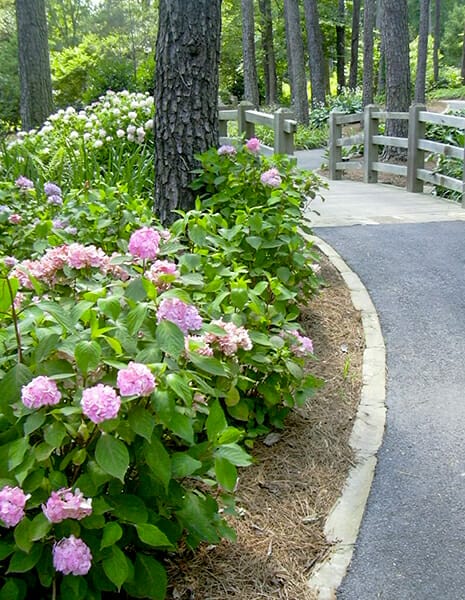 Aldridge Gardens Hydrangeas
Perhaps the greatest contribution to modern nursery production came out of research conducted jointly by researchers at Auburn University, the University of Georgia, and Mississippi State University to develop processed pinebark as a substitute for mineral-based soil in container production. The use of this soilless growing substrate solved many problems associated with field soils, including root diseases and difficulty in water management. Most of all, the new substrate was much lighter and thus reduced worker fatigue and injury as well as shipping and handling costs.
Aldridge Gardens Hydrangeas
Perhaps the greatest contribution to modern nursery production came out of research conducted jointly by researchers at Auburn University, the University of Georgia, and Mississippi State University to develop processed pinebark as a substitute for mineral-based soil in container production. The use of this soilless growing substrate solved many problems associated with field soils, including root diseases and difficulty in water management. Most of all, the new substrate was much lighter and thus reduced worker fatigue and injury as well as shipping and handling costs.
Another notable figure in Alabama is long-time Bessemer nurserymen Eddie Aldridge. In 1971 Aldridge and his father, Loren, received a patent for and introduced into the trade the “Snowflake” variety of the oakleaf hydrangea (Hydrangea quercifolia). This sterile form of the native oakleaf hydrangea has proven to be one of the most popular varieties with the gardening public. The Aldridges also introduced and named the “Harmony” oakleaf hydrangea, named after Harmony Baptist Church in Rainbow City, Etowah County, where it had been transplanted from the wild. Large plantings of these and other hydrangeas can be seen at Aldridge Gardens in Hoover, Jefferson County.
Further Reading
- Davidson, Harold, and Roy Mecklenburg. Nursery Management: Administration and Culture. Englewood Cliffs, N.J.: Prentice-Hall, 1981.
- Southern Nursery Association. The History of the Southern Nursery Association. Atlanta: Southern Nursery Association, 1999.
